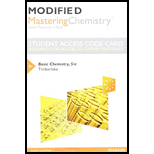
Concept explainers
Interpretation: The following problem can be comprehended by the concept of heat.
Concept introduction: Heat capacity is a physical quantity which is equal to the ratio of heat given to (or taken from) the object to the resultant change in temperature. Its SI unit is joule/ Kelvin. It is an extensive attribute of matter. When the heat capacity is calculated per unit molefor a substance, it is called molar heat capacity while it is called specific heat capacity or specific heat, when it is measured per unit mass for a substance. For aparticular substance, heat capacity is directly proportional to the quantity of the substance present. Yet the specific heat is an attribute of the structure of a substance. It depends on the number of available degrees of freedom in the particular substance, which permits the particles of the substance to accumulate thermal energy.
Given: Here, we are given that when a metal (titanium or aluminium) weighing 4.7 g absorbs 11 J of energy, its temperature increases by 4.5 °C. We are asked to find out the specific heat (J/g °C) of the metal and identify whether the metal is titanium or aluminium.
Want to see the full answer?
Check out a sample textbook solution
Chapter 3 Solutions
Modified Masteringchemistry With Pearson Etext -- Standalone Access Card -- For Basic Chemistry Format: Access Card Package
 ChemistryChemistryISBN:9781305957404Author:Steven S. Zumdahl, Susan A. Zumdahl, Donald J. DeCostePublisher:Cengage Learning
ChemistryChemistryISBN:9781305957404Author:Steven S. Zumdahl, Susan A. Zumdahl, Donald J. DeCostePublisher:Cengage Learning ChemistryChemistryISBN:9781259911156Author:Raymond Chang Dr., Jason Overby ProfessorPublisher:McGraw-Hill Education
ChemistryChemistryISBN:9781259911156Author:Raymond Chang Dr., Jason Overby ProfessorPublisher:McGraw-Hill Education Principles of Instrumental AnalysisChemistryISBN:9781305577213Author:Douglas A. Skoog, F. James Holler, Stanley R. CrouchPublisher:Cengage Learning
Principles of Instrumental AnalysisChemistryISBN:9781305577213Author:Douglas A. Skoog, F. James Holler, Stanley R. CrouchPublisher:Cengage Learning Organic ChemistryChemistryISBN:9780078021558Author:Janice Gorzynski Smith Dr.Publisher:McGraw-Hill Education
Organic ChemistryChemistryISBN:9780078021558Author:Janice Gorzynski Smith Dr.Publisher:McGraw-Hill Education Chemistry: Principles and ReactionsChemistryISBN:9781305079373Author:William L. Masterton, Cecile N. HurleyPublisher:Cengage Learning
Chemistry: Principles and ReactionsChemistryISBN:9781305079373Author:William L. Masterton, Cecile N. HurleyPublisher:Cengage Learning Elementary Principles of Chemical Processes, Bind...ChemistryISBN:9781118431221Author:Richard M. Felder, Ronald W. Rousseau, Lisa G. BullardPublisher:WILEY
Elementary Principles of Chemical Processes, Bind...ChemistryISBN:9781118431221Author:Richard M. Felder, Ronald W. Rousseau, Lisa G. BullardPublisher:WILEY





